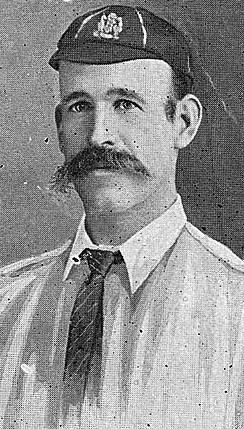Batting style Left-hand bat Role Cricket Player Name Bill Howell | National side Australian Bowling style Right-arm medium | |
 | ||
Died 1950, Castlereagh, Sydney, Australia | ||
William Peter Howell (born 29 December 1869, Penrith, New South Wales. died 14 July 1940, Castlereagh, New South Wales) was an Australian cricketer who played in 18 Tests from 1898 to 1904.
He made his Test debut, Australia v England at Adelaide in January 1898 playing in 18 Test matches until 1904.
Howell's finest achievement was taking 10-28 against Surrey during Australia's 1899 tour of England.
The Cricket oval at Penrith Stadium is named after Bill Howell.
In January 1898, Bill Howell played in his first test match against England at Adelaide Oval and made two trips to England in 1899 and 1902, and to South Africa in 1902. In August that year Tom Dickson convened a meeting of local cricketers at the Commercial Hotel in Penrith and as a result the Nepean District Cricket Association was formed. Its competition trophy was the Lees Shield presented by Local Member Samuel Lees which was to become the property of the first club to win it three times. That honour went to the Castlereagh Club.
Locally, in one match Howell took ten wickets for ten runs, and in another hit seven sixes from a seven ball over. While overseas in 1902, his parents, George and Hannah (Colless) Howell died within days of each other. They owned two farms valued at £1,165. After his retirement from international cricket Bill Howell returned to one farm at Castlereagh, while his brother Athol took up the adjoining farm. In 1899, Bill married Neva, the daughter of James and Sarah Hunter of Emu Plains.
In 1957, Howell Oval in Penrith was dedicated to the cricketing achievements of William Peter Howell.
William Peter Howell was to become renowned as one of Australia's most eminent Test bowlers, despite having to play for most of his career in the same side as that bowling genius, Hugh Trumble. On Australian wickets, the srtongly-built farm lad with the biggest of handlebar moustaches used a skillful variation of flight and pace to deceive opposition batsmen into an act of self-destruction. In England, his ability to impart massive spin on the ball enabled him to beat the bat consistently with turn. The snap of Howell's strong fingers caused the ball to literally buzz in its flight towards the awaiting batsman - an appropriate result for a New South Wales beekeeper. Quicker than Trumble, his main weapon was a devastating off-break but Howell also used a quick-turning leg-break as a variation. Even on the hard turf of Australia he could turn the ball more than his colleagues. Howell claimed all 10 Surrey wickets for 28 in his first bowling stint in England in 1899.
Howell also appreciated the value of the ball that whips straight on without turning and was of great value to a succession of Australian teams in England, except on a sticky wicket when his break was sometimes too big. When Joe Darling took his team to South Africa for the first time in 1902-03, Howell ensured success for Australia in a three-match Test series by taking 14 wickets at 12.42 in the two games he played.
From a 1967 NT News newspaper article about that tour of South Africa:
But the highlight of the Australian tour was the devastating off-spin bowling of Bill Howell. Left out of the first match because he was thought to be out of form, Howell played in the next five and took 48 wickets at a cost of just over nine runs each. A farmer from Rooty Hill near Sydney and a man with huge hands, Howell was noted for the amount of work he got on the ball. In South Africa Howell was almost unplayable. Deliveries turning viciously from outside the off-stump sometimes had the effect of making the shaken batsman turn his head first over one shoulder, then the other, wondering what had happened to the ball.
